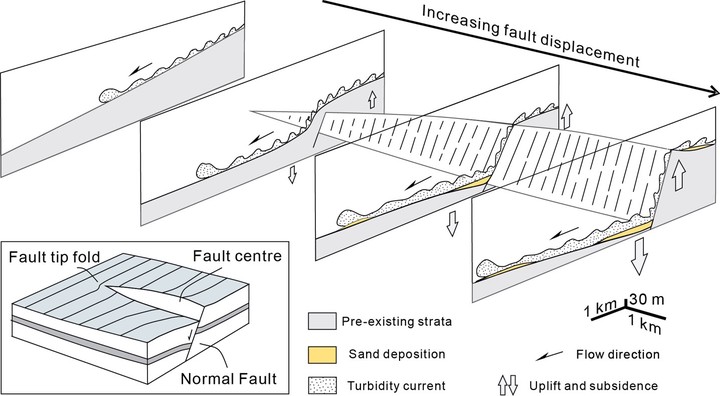 Along strike variations of normal fault topography controls the hydraulic behavours of associated turbidty current
Along strike variations of normal fault topography controls the hydraulic behavours of associated turbidty current摘要
Turbidity currents descending the slopes of deep‐water extensional basins or passive continental margins commonly encounter normal‐fault escarpments, but such large‐magnitude phenomena are hydraulically difficult to replicate at small scale in the laboratory. This study uses advanced computational fluid dynamics numerical simulations to monitor the response of large, natural‐scale unconfined turbidity currents (100 m thick and 2000 m wide at the inlet gate) to normal‐fault topography with a maximum relief of nearly 300 m. For comparative purposes, the turbidity current is first released on a non‐faulted pristine slope of 1·5° (simulation model 1). The expanding and waxing flow bypasses the slope without recognizable deposition within the visibility limit of 8 vol.% sand grain packing. Similar flow is then released towards the tip (model 2) and towards the centre (model 3) of a normal‐fault escarpment. In both of these latter models, the sand carried by flow tends to be entrapped in four distinct depozones: an upslope near‐gate zone of flow abrupt expansion and self‐regulation; a flow‐transverse zone at the fault footwall edge; a flow‐transverse zone at the immediate hangingwall; and a similar transverse zone near the crest of the hangingwall counter‐slope, where some of the deposited sand also tends to be reshuffled to the previous zone by a secondary reverse underflow. The near‐bottom reverse flow appears to be generated on a counter‐slope of 1·1°, increased to 2·0° by deposition. The Kelvin–Helmholtz interface instability plays an important role by causing three‐dimensional fluctuations in the flow velocity magnitude and sediment concentration. The thick deposits of large single‐surge flows may thus show hydraulic fluctuations resembling those widely ascribed to hyperpycnal flows. The study indicates further that the turbiditic slope fans formed on such fault topographies are likely to be patchy and hence may differ considerably from the existing slope‐fan conceptual models when it comes to the spatial prediction of main sand depozones.